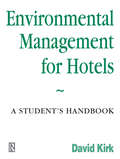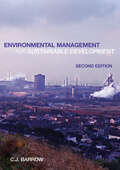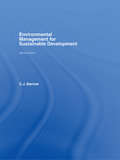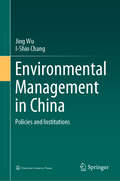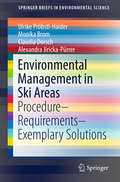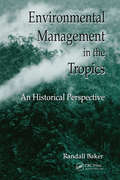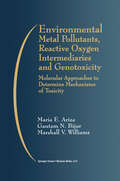- Table View
- List View
Environmental Management for Hotels
by David KirkEnvironmental Management for Hotels is a textbook for hospitality students that covers the relatively new field of environmental management. The reader is guided in how to make decisions which allow hotels to obtain optimum benefits for the environment whilst not threatening their own financial viability. Students are given an understanding of both the concepts and practical implications of environmental challenges relating to hotels. The case study material incorporated ties in theory with real life, and provides an international context. The text emphasizes supervisory issues which relate to the management of hospitality operations in ways which are sensitive to the impact on the environment. The main areas of environmental management featured are: *water *energy *the indoor environment *materials and waste.
Environmental Management for Hotels
by David KirkEnvironmental Management for Hotels is a textbook for hospitality students that covers the relatively new field of environmental management. The reader is guided in how to make decisions which allow hotels to obtain optimum benefits for the environment whilst not threatening their own financial viability. Students are given an understanding of both the concepts and practical implications of environmental challenges relating to hotels. The case study material incorporated ties in theory with real life, and provides an international context. The text emphasizes supervisory issues which relate to the management of hospitality operations in ways which are sensitive to the impact on the environment. The main areas of environmental management featured are: *water *energy *the indoor environment *materials and waste.
Environmental Management for Sustainable Development
by Chris BarrowEnvironmental management is a wide, expanding, and rapidly evolving field, affecting everyone from individual citizens to businesses; governments to international agencies. Indisputably, it plays a crucial role in the quest for sustainable development. This comprehensively updated second edition explores the nature and role of environmental management, covering key principles, practices, tools, strategies and policies, offers a thorough yet understandable introduction, and points to further in-depth coverage. Among the key themes covered are: sustainable development proactive approaches the precautionary principle the ‘polluter pays’ principle the need for humans to be less vulnerable and more adaptable. Reflecting the expansion and evolution of the field, this revised edition focuses strongly on sustainable development. There has been extensive restructuring to ensure the book is accessible to those unfamiliar with environmental management and it now includes greater coverage of topics including key resources under stress, environmental management tools, climate change and urban environmental management. With rapid expansion and development of the subject it is easy for those embarking on a course of study to become disorientated, but with its well-structured coverage, effective illustrations, and foundation for further, more-focused interest, this book is easily accessible to all.
Environmental Management for Sustainable Development
by Chris BarrowEnvironmental management is a wide, expanding, and rapidly evolving field, affecting everyone from individual citizens to businesses; governments to international agencies. Indisputably, it plays a crucial role in the quest for sustainable development. This comprehensively updated second edition explores the nature and role of environmental management, covering key principles, practices, tools, strategies and policies, offers a thorough yet understandable introduction, and points to further in-depth coverage. Among the key themes covered are: sustainable development proactive approaches the precautionary principle the ‘polluter pays’ principle the need for humans to be less vulnerable and more adaptable. Reflecting the expansion and evolution of the field, this revised edition focuses strongly on sustainable development. There has been extensive restructuring to ensure the book is accessible to those unfamiliar with environmental management and it now includes greater coverage of topics including key resources under stress, environmental management tools, climate change and urban environmental management. With rapid expansion and development of the subject it is easy for those embarking on a course of study to become disorientated, but with its well-structured coverage, effective illustrations, and foundation for further, more-focused interest, this book is easily accessible to all.
Environmental Management in China: Policies and Institutions
by Jing Wu I-Shin ChangThis book details various stages in the introduction, establishment and evolution of China’s environmental management system. By combining a literature review, comparative analysis, and case study, it investigates the environmental management system in several key periods in order to systematically assess the necessary measures and appropriate adjustments the Chinese Government implemented to reconcile the growing conflicts between economic development and resources conservation, in the context of rapid economic growth and economic transformation. Given its scope, the book offers a valuable resource for experts, scholars, and government officials in related fields.
Environmental Management in India: Waste to Wealth
by Shalini Yadav Abdelazim M. Negm Ram Narayan YadavaThis book presents unique connectivity between waste management within the agenda 2030 of India. This book is the first publication presenting up-to-date work and knowledge about waste management and waste technologies to transfer waste to wealth in India. Besides, this book also presents the role of waste management and its contribution to achieving a sustainable development program in India, with vast implication worldwide. The main focuses of the book include waste and wealth and the associated technologies, recycling of solid waste, utilization of hazardous waste, use of nanoparticle in waste management, urban solid waste, generation of energy from organic waste, clean technologies, and use of waste in agriculture. The book is a unique source of information on the transformation of waste to wealth in India. This book is of interest to research communities in the field of waste management in India, and in similar socioeconomic countries, but also, due to the planetary implications, has global interest.
Environmental Management in Ski Areas: Procedure—Requirements—Exemplary Solutions (SpringerBriefs in Environmental Science)
by Ulrike Pröbstl-Haider Monika Brom Claudia Dorsch Alexandra Jiricka-PürrerThis book raises awareness of environmentally friendly and resource-sparing management of winter sports areas, in order to increase the number of certified ski areas. Many ski areas today are advertised with seals of approval, titles and awards. Often, however, it is unclear which institutions and criteria are behind these appraisals. This practice is widely criticized as “green-washing”, since a cautious use of ecologically and scenically sensitive mountain areas is more important now than ever. An environmental management system based on international or European standards ensures “real” improvements and external evaluation, but relies on the personal responsibility of the providers rather than on regulations imposed by authorities. This book contributes to developing a trustworthy and unified system for such evaluation, and one that can be applied internationally.
Environmental Management in the Tropics: An Historical Perspective
by Randall BakerThe arrival of western science and economic interests to the tropics has dramatically changed the tropical environment and its ecology. Environmental Management in the Tropics discusses the ecology of the tropics and examines how it is different from the temperate zone where western science evolved. The author discusses how native people traditionally subsisted in different ecological zones of the tropics and how they rationalized their relationship. The author also takes a critical look at the impact of colonialism in the tropics and how it changed traditional cultures and their relationship with the environment. The current clash between economics and ecology in the tropics is explored in depth. According to the author, we are now able to draw "a line in the sand" and illustrate the consequences of continuing current practices. Environmental Management in the Tropics shows how this situation developed and discusses how the two opposing concepts must be brought back into harmony. The book is one of the few studies to take a truly interdisciplinary approach combining the serious inevitabilities of natural science with the variables of history, culture, politics, and economics. It gives us a new respect for the past and tradition of the tropics and clearly spells out why dramatic changes must occur to prevent further degradation of the tropical environment.Environmental Management in the Tropics is an important reference for ecologists, conservationists, scientists, researchers, environmental consultants, land managers and developers, members of the world regulatory community, and anyone working on projects in tropical regions.
Environmental Management in the Tropics: An Historical Perspective
by Randall BakerThe arrival of western science and economic interests to the tropics has dramatically changed the tropical environment and its ecology. Environmental Management in the Tropics discusses the ecology of the tropics and examines how it is different from the temperate zone where western science evolved. The author discusses how native people traditionally subsisted in different ecological zones of the tropics and how they rationalized their relationship. The author also takes a critical look at the impact of colonialism in the tropics and how it changed traditional cultures and their relationship with the environment. The current clash between economics and ecology in the tropics is explored in depth. According to the author, we are now able to draw "a line in the sand" and illustrate the consequences of continuing current practices. Environmental Management in the Tropics shows how this situation developed and discusses how the two opposing concepts must be brought back into harmony. The book is one of the few studies to take a truly interdisciplinary approach combining the serious inevitabilities of natural science with the variables of history, culture, politics, and economics. It gives us a new respect for the past and tradition of the tropics and clearly spells out why dramatic changes must occur to prevent further degradation of the tropical environment.Environmental Management in the Tropics is an important reference for ecologists, conservationists, scientists, researchers, environmental consultants, land managers and developers, members of the world regulatory community, and anyone working on projects in tropical regions.
Environmental Management In Tropical Agriculture
by Robert GoodlandAddressing the problem of the high cost of agricultural development in tropical regions, this book summarizes the environmental concerns associated with tropical agriculture. The authors highlight major environmental hazards confronted in tropical agriculture and suggest specific management options that could be used to reduce or avoid them. The fi
Environmental Management In Tropical Agriculture
by Robert GoodlandAddressing the problem of the high cost of agricultural development in tropical regions, this book summarizes the environmental concerns associated with tropical agriculture. The authors highlight major environmental hazards confronted in tropical agriculture and suggest specific management options that could be used to reduce or avoid them. The fi
Environmental Management: Issues and Concerns in Developing Countries
by Pradip K. SikdarThis book deals with issues and concerns for the human environment in the developing countries incorporating natural processes and systems, pollution removal technology, energy conservation, environmental impact assessment process, economics, culture, political structure and societal equity from a management point of view. Solutions to the emerging problems of the environment need a paradigmatic shift in approach from a process based model to a socio-political-economic model. Hence environmental management should involve equality and control over use of the finite natural resources and the balance between Earth’s biocapacity and humanity’s ecological footprint. Changes such as green technologies, human population stabilization and adoption of ecologically harmonious lifestyles are absolutely essential and will require redesigning of political institutions, policies and revisiting forgotten skills of sustainable practices of environmental management. These challenges should centre on environment governance using the concepts of common property, equity and security.This book is relevant for academics, professionals, administrators and policy makers who are concerned with various aspects of environment management and governance.
Environmental Management of Marine Ecosystems (Applied Ecology and Environmental Management)
by Nazrul Islam Sven Erik JorgensenEcosystem-Based Management (EBM) is one of the most holistic approaches to protecting marine and coastal ecosystems as it recognizes the need to protect entire marine ecosystems instead of individual species. After decades of pollution, habitat degradation and overfishing, now climate change and ocean acidification threaten the health of the ocean in unprecedented way. Environmental Management of Marine Ecosystems illustrates the current status, trends, and effects of climate, natural disturbances and anthropogenic impacts on marine ecosystems. It demonstrates how to integrate different management tools and models in an up-to-date, multidisciplinary approach to environmental management. This indispensable guide provides several case studies from around the world and creates a framework for identifying management tools and their applications in coral reefs, fisheries, migratory species, marine islands and associated ecosystems such as mangroves and sea grass beds. It discusses the physical and chemical compositions of marine ecosystems along with the threats and actions needed to protect them. The application of model framework to several contemporary management issues include the modelling of harmful algal bloom dynamics, understanding the dispersal of sea lice, and the possible impacts on intertidal communities of the provision of novel offshore habitat. The results of extensive research by an international team of contributors, the Environmental Management of Marine Ecosystems is designed to inform scientists, practitioners, academics, government and non-government policymakers on the particularities of marine ecosystems and assist them in understanding the EBM approaches in means of mitigation and adaptation of human activities that result in sustainability. These practices will help change the current methodologies used for resource assessment and the future regulations of marine resources.
Environmental Management of Marine Ecosystems (Applied Ecology and Environmental Management)
by Md. Nazrul Islam and Sven Erik JørgensenEcosystem-Based Management (EBM) is one of the most holistic approaches to protecting marine and coastal ecosystems as it recognizes the need to protect entire marine ecosystems instead of individual species. After decades of pollution, habitat degradation and overfishing, now climate change and ocean acidification threaten the health of the ocean in unprecedented way. Environmental Management of Marine Ecosystems illustrates the current status, trends, and effects of climate, natural disturbances and anthropogenic impacts on marine ecosystems. It demonstrates how to integrate different management tools and models in an up-to-date, multidisciplinary approach to environmental management. This indispensable guide provides several case studies from around the world and creates a framework for identifying management tools and their applications in coral reefs, fisheries, migratory species, marine islands and associated ecosystems such as mangroves and sea grass beds. It discusses the physical and chemical compositions of marine ecosystems along with the threats and actions needed to protect them. The application of model framework to several contemporary management issues include the modelling of harmful algal bloom dynamics, understanding the dispersal of sea lice, and the possible impacts on intertidal communities of the provision of novel offshore habitat. The results of extensive research by an international team of contributors, the Environmental Management of Marine Ecosystems is designed to inform scientists, practitioners, academics, government and non-government policymakers on the particularities of marine ecosystems and assist them in understanding the EBM approaches in means of mitigation and adaptation of human activities that result in sustainability. These practices will help change the current methodologies used for resource assessment and the future regulations of marine resources.
Environmental Management of Solid Waste: Dredged Material and Mine Tailings
by Wim Salomons and Ulrich FörstnerDredged Material and Mine Tailings are two of the same thing once they are deposited on land: they must be safe-guarded, wash-out must be prevented, and they must be protected by a plantcover. This comprehensive two-volume treatise covers both important aspects of their management: Environmental Management of Solid Waste turns to the practical applications, such as prediction, restoration and management, while in Chemistry and Biology of Solid Waste the principles and assessment are scientifically studied and discussed. Previously, dredged material was a commodity, it could be sold as soil, e. g. to gardeners. In the meantime, dredged material from the North Sea (e.g. the Rotterdam or Amsterdam harbor) must be treated as hazardous waste. Many environmentalists, managers and companies do not know how to solve the inherent problems. This new work deals with the chemical, physical and biological principles; the biological and geochemical assessment; the prediction of effects and treatment; and finally, with restoration and revegetation. It is written by many leading scientists in the various fields, and will prove invaluable for managers and politicians who are concerned with the present environmental situation.
Environmental Management Plans Demystified: A Guide to ISO14001
by Stephen TinsleyThe development of an environmental management plan is an essential business activity that helps organise, direct and control operational activities, and plan for future environmental risk. Once created, an environmental management plan is an ongoing asset that requires regular updating and enables benchmarking against company targets and competitors. Environmental Management Plans Demystified takes you step-by-step through the process and procedures required to implement a successful plan. Its clear, accessible style allows you to achieve ISO 14001 compliance with the minimum of effort. Examples of standard documentation, case studies, flowcharts, and checklists are included, as well as useful hints to avoid resource-wasting pitfalls. If you want to install a successful environmental management plan that will minimise environmental risk and create a competitive advantage for your company, this book is an essential practical guide for both the absolute beginner and the experienced practitioner.
Environmental Management Plans Demystified: A Guide to ISO14001
by Stephen TinsleyThe development of an environmental management plan is an essential business activity that helps organise, direct and control operational activities, and plan for future environmental risk. Once created, an environmental management plan is an ongoing asset that requires regular updating and enables benchmarking against company targets and competitors. Environmental Management Plans Demystified takes you step-by-step through the process and procedures required to implement a successful plan. Its clear, accessible style allows you to achieve ISO 14001 compliance with the minimum of effort. Examples of standard documentation, case studies, flowcharts, and checklists are included, as well as useful hints to avoid resource-wasting pitfalls. If you want to install a successful environmental management plan that will minimise environmental risk and create a competitive advantage for your company, this book is an essential practical guide for both the absolute beginner and the experienced practitioner.
Environmental Management Technologies: Challenges and Opportunities
by Pankaj Chowdhary Vineet Kumar Sunil Kumar Vishvas HareEnvironmental Management Technologies: Challenges and Opportunities details the environmental problems posed by the various types of toxic organic and inorganic pollutants discharged from both natural and anthropogenic activities and their toxicological effects in environments, humans, animals, and plants. This book also highlights the recent advanced and innovative methods for the effective degradation and bioremediation of organic pollutants, heavy metals, dyes, etc. from the environment for sustainable development. Features of the book: · Provides state-of-the-art information on pollutants, their sources, and deleterious impacts on the environment · Elucidates the recent updates on Emerging Pollutants (EPs) in pharmaceutical waste and personal care products · Discusses the various physico-chemical, biological, and combination treatment systems for sustainable development · Details recent research findings in the area of environmental waste management and their future challenges and opportunities
Environmental Management Technologies: Challenges and Opportunities
by Pankaj Chowdhary Vineet Kumar Sunil Kumar Vishvas HareEnvironmental Management Technologies: Challenges and Opportunities details the environmental problems posed by the various types of toxic organic and inorganic pollutants discharged from both natural and anthropogenic activities and their toxicological effects in environments, humans, animals, and plants. This book also highlights the recent advanced and innovative methods for the effective degradation and bioremediation of organic pollutants, heavy metals, dyes, etc. from the environment for sustainable development. Features of the book: · Provides state-of-the-art information on pollutants, their sources, and deleterious impacts on the environment · Elucidates the recent updates on Emerging Pollutants (EPs) in pharmaceutical waste and personal care products · Discusses the various physico-chemical, biological, and combination treatment systems for sustainable development · Details recent research findings in the area of environmental waste management and their future challenges and opportunities
Environmental Mechanochemistry: Recycling Waste into Materials using High-Energy Ball Milling
by Matej BalážThis book provides a comprehensive overview on mechanochemistry including its history, high-energy ball milling process, equipment used and fundamentals behind the observed scientific phenomena. It also shows that mechanochemistry is highly applicable in the field of waste treatment. The text reviews 1017 studies utilizing mostly high-energy ball milling for the treatment of various types of consumer, technogenic and agricultural waste. The text is divided into chapters based on individual waste types. The book presents an Appendix compiling all studies arranged according to the application that the recycled waste is meant for. In this way, readers from both academia and companies interested either in the treatment of a particular waste, or particular application might easily locate sections of interest.
Environmental Medicine
by Jon Ayres Roy Harrison Gordon Nichols Robert Maynard CBEEnvironmental Medicine is an indispensable aid to the investigation, diagnosis and treatment of a wide variety of environmentally-acquired disorders. It brings into sharp focus the increasing importance of the practice of environmental medicine, drawing together the many different strands that make up this modern discipline, and putting topical and
Environmental Metal Pollutants, Reactive Oxygen Intermediaries and Genotoxicity: Molecular Approaches to Determine Mechanisms of Toxicity
by Maria E. Ariza Gautam N. Bijur Marshall V. WilliamsHumans are exposed daily to low concentrations of metals that are released into the environment by both natural and industrial processes. Environmental Metal Pollutants, Reactive Oxygen Intermediaries and Genotoxicity: Molecular Approaches to Determine Mechanisms of Toxicity examines concerns about the acute and/or chronic exposure of humans to concentrations of these metals that are below the threshold levels established by various federal regulatory agencies. Some of these metals are accumulated in various tissues and over time this may result in the accumulation of a significant body burden. This could increase the risk of developing a variety of diseases later in life, at a time when thresholds for such effects may already be reduced by the processes of aging. Such possibilities could only further compromise the quality of life in the elderly population and could contribute to the rising cost of health care in this country. Studies that have been conducted to determine the possible risks associated with exposure to relatively non-toxic concentrations of environmental metals have been hampered by a lack of appropriate models and a lack of funding. It has also been difficult for researchers to demonstrate a correlation between the exposure of humans or animals to low concentrations of environmental pollutants and disease. This book examines recent technological advances in the areas of molecular biology, biochemistry, and computer-enhanced image analyses that provide researchers with the tools to begin elucidating the genotoxic effects of environmental metal pollutants and the mechanisms by which these metals cause DNA damage. Environmental Metal Pollutants, Reactive Oxygen Intermediaries and Genotoxicity: Molecular Approaches to Determine Mechanisms of Toxicity presents data that demonstrate that certain environmental metal pollutants are genotoxic. The authors describe the role of reactive oxygen intermediates in causing the DNA damage induced by environmental metal pollutants and discuss their possible role in human disease.
Environmental Methods for Transport Noise Reduction
by Mats Nilsson Jörgen Bengtsson Ronny KlaeboePresents Evidence-Based Guidance on Noise Abatement MethodsSolutions for reducing the noise impact of road and rail traffic can be found in the use of natural elements in combination with artificial elements in urban and rural environments. Ground and road surface treatments; trees, forests, and tall vegetation; and the greening of buildings and ot
Environmental Microbial Biotechnology (Soil Biology #45)
by Lala Behari Sukla Nilotpala Pradhan Sandeep Panda Barada Kanta MishraThis book provides a timely review of strategies for coping with polluted ecosystems by employing bacteria, fungi and algae. It presents the vast variety of microbial technologies currently applied in the bioremediation of a variety of anthropogenic toxic chemicals, mining and industrial wastes and other pollutants.Topics covered include: microbe-mineral interactions, biosensors in environmental monitoring, iron-mineral transformation, microbial biosurfactants, bioconversion of cotton gin waste to bioethanol, anaerobe bioleaching and sulfide oxidation. Further chapters discuss the effects of pollution on microbial diversity, as well as the role of microbes in the bioremediation of abandoned mining areas, industrial and horticultural wastes, wastewater and sites polluted with hydrocarbons, heavy metals, manganese and uranium.
Environmental Microbial Evolution: Methods and Protocols (Methods in Molecular Biology #2569)
by Haiwei LuoThis volume explores the latest techniques used to study environmental microbial evolution, with a focus on methods capable of addressing deep evolution at long timescales. The chapters in this book are organized into three parts. Part One introduces molecular dating approaches and time calibration ideas that allow for the determination of evolutionary timescales of microbial lineages. Part Two describes several advanced phylogenomic tools such as models for genome tree construction, a taxon sampling method, outgroup-independent tree-rooting methods, and gene family evolution models. Part Three covers techniques used to study trait evolution. Written in the highly successful Methods in Molecular Biology series format, chapters include introductions to their respective topics, lists of the necessary materials and reagents, step-by-step, readily reproducible laboratory protocols, and tips on troubleshooting and avoiding known pitfalls.Cutting-edge and comprehensive, Environmental Microbial Evolution: Methods and Protocols is a valuable tool for all researchers who are interested in learning more about this important and evolving field.
